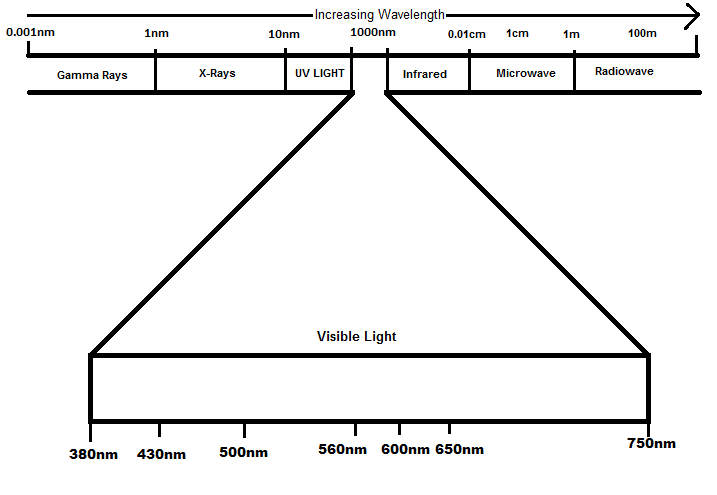
The broad wavelength range of visible spectrum is:
(A) $ 4000 - 8000{A^\circ } $
(B) $ 2000 - 4000{A^\circ } $
(C) $ 10000 - 20000{A^\circ } $
(D) None of the above
Answer
486.9k+ views
Hint :Human eyes can only sense the visible spectrum of the whole electromagnetic spectrum whereas few animals can detect infrared, radio, etc waves. The broad wavelength range of the visible spectrum refers to the range of electromagnetic radiation which causes the maximum sensation of colours in the human eyes.
Complete Step By Step Answer:
Electromagnetic radiation or EM waves refer to the fluctuation of mutually perpendicular electric and magnetic fields which propagate throughout the universe. These radiations are produced mainly in the stars where the excited atoms when returning to their ground state eject these waves in forms of photons.
The range of these EM waves is quite vast. Their wavelength ranges from $ {10^{ - 18}}m $ to $ {10^6}m $ . These include waves in increasing order of their wavelengths as Gamma rays>X-rays>Ultraviolet rays>Visible light>Infrared rays>Microwave rays>Radio waves. The figure below depicts the range of different waves:

For visible light the accurate range is $ 3800 - 8000{A^\circ } $ . Hence the broad range of electromagnetic radiation for visible spectrum is $ 4000 - 8000{A^\circ } $ .
The correct answer is option A.
Note :
Be careful about the units of the wavelengths. Generally, the wavelengths are expressed in Armstrong but sometimes to confuse the students it is given in nano-meters. In a nano-meter the range would be 400-800 nm.
Complete Step By Step Answer:
Electromagnetic radiation or EM waves refer to the fluctuation of mutually perpendicular electric and magnetic fields which propagate throughout the universe. These radiations are produced mainly in the stars where the excited atoms when returning to their ground state eject these waves in forms of photons.
The range of these EM waves is quite vast. Their wavelength ranges from $ {10^{ - 18}}m $ to $ {10^6}m $ . These include waves in increasing order of their wavelengths as Gamma rays>X-rays>Ultraviolet rays>Visible light>Infrared rays>Microwave rays>Radio waves. The figure below depicts the range of different waves:

For visible light the accurate range is $ 3800 - 8000{A^\circ } $ . Hence the broad range of electromagnetic radiation for visible spectrum is $ 4000 - 8000{A^\circ } $ .
The correct answer is option A.
Note :
Be careful about the units of the wavelengths. Generally, the wavelengths are expressed in Armstrong but sometimes to confuse the students it is given in nano-meters. In a nano-meter the range would be 400-800 nm.
Recently Updated Pages
Master Class 12 Business Studies: Engaging Questions & Answers for Success

Master Class 12 Economics: Engaging Questions & Answers for Success

Master Class 12 English: Engaging Questions & Answers for Success

Master Class 12 Maths: Engaging Questions & Answers for Success

Master Class 12 Social Science: Engaging Questions & Answers for Success

Master Class 12 Chemistry: Engaging Questions & Answers for Success

Trending doubts
Which are the Top 10 Largest Countries of the World?

Differentiate between homogeneous and heterogeneous class 12 chemistry CBSE

Why is the cell called the structural and functional class 12 biology CBSE

Who discovered the cell and how class 12 biology CBSE

What is the Full Form of PVC, PET, HDPE, LDPE, PP and PS ?

Derive an expression for electric potential at point class 12 physics CBSE




